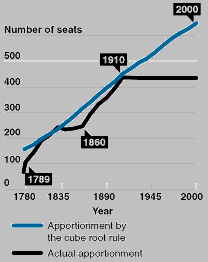
Growth in U.S. Population Calls for Larger House of Representatives
(April 2000) Controversy over the use of sampling in the 2000 census for reapportionment prompted a Supreme Court decision and protracted congressional deliberations. Interestingly, the controversy did not prompt Congress to investigate the nuts and bolts of reapportionment.
The formula for allocating seats in the House of Representatives among the states according to their population has gone fundamentally unchallenged since 1940.
The reason may be that few Americans know how the size of the House is set. Only since 1910 has the House of Representatives had 435 members. In 1792 there were only 106 members. And although the House generally expanded each decade, between 1830 and 1840 Congress made the House smaller after a census and reapportionment.
The framers of the Constitution expected the House to grow with the population. Alexander Hamilton and James Madison, in Federalist no. 58, noted that the purpose of the census was to “readjust, from time to time, the apportionment of representatives to the number of inhabitants . . . [and] to augment the number of representatives . . . under the sole limitation that the whole number shall not exceed one for every thirty thousand inhabitants . . . “
Since 1910, however, Congress has not increased the size of the House. In that year, the population was 92 million, and each House member represented about 210,000 people. Today the number is 572,000, and it will jump to about 630,000 after the 2000 census. Will that increase continue? What is the “right” number?
Rein Taagepera and Matthew S. Shugart, who analyze apportionment systems around the world, have found that the size of the largest legislative body of a national legislature today tends to be the cube root of the population — a number that, when multiplied by itself twice, yields the voting-age population. For example, the voting-age population was 203,578,000 in 1990, and the whole number closest to being the cube root of that population is 588 (588 x 588 x 588 = 203,297,472). Although that formula tracked the size of the House fairly well between 1790 and 1910, the discrepancy between the current House size and the “cube root of population” rule is so great that restoring that relationship would require adding more than 150 members to the House (see figure below).

Source: Author’s analysis.
Taagepera believes that the cube root rule should prevail because it would maximize efficiency and reduce the influence of nonelected congressional staffs. If more representatives were added, he thinks that the number of communication channels per representative — both in assembly and toward constituents — would decline and that efficiency would increase. One aspect of that efficiency would, in his view, be a diminished need for large congressional staffs, which Taagepera holds have mushroomed to compensate for the small size of the U.S. House. If Congress decided to enlarge its membership, it could at the same time limit or cut the size of support staff, he believes.
Shugart feels similarly. “My guess,” he said, “is that what would happen with a much larger House is that members would come to rely more on their parties to deliver the representation that constituents want . . . There would be necessarily less ‘pork’ and more policy arising out of a larger House.”
Because such a change would unsettle politics as usual in undetermined ways, it is not surprising that few incumbent politicians talk about the issue. In 1996 and again in 1997, House members introduced bills to establish a commission that would make recommendations on the appropriate size of the House and the method by which representatives are elected. Neither bill made it to committee.
James Clyburn, D-S.C., current chairman of the Congressional Black Caucus, favors “alternative voting methods” such as proportional or cumulative voting in multimember districts, which might lead to or be paired with expanding the House of Representatives. But the Caucus has not taken a position on expanding the House.
Nonetheless, there are a number of potential supporters outside the political arena. Rob Richie, of the Center for Voting and Democracy, noted that, “In state legislatures, women do better in districts that are smaller,” and that there would be (with more House members) “more opportunities for districts drawn to facilitate racial minorities without contorting lines.” Richie speculated that enlarging the House would appeal to populists, because smaller House districts might elect more “ordinary folks.”
There are many ways for regions, parties, and factions to seek advantages in the decennial process of census-taking and reapportionment. Debates about the propriety of sampling are merely the tip of the iceberg. Perhaps in 2010, a full century after Congress last increased the size of the House, Americans will take a look at the issue. It may not be too soon to start the conversation now.
Margo Anderson is a professor of American history at the University of Wisconsin-Milwaukee. She is co-author, with Stephen E. Fienberg, of Who Counts? The Politics of Census-Taking in Contemporary America (New York: Russell Sage Foundation, 1999).
